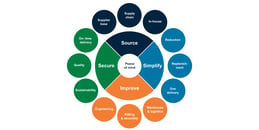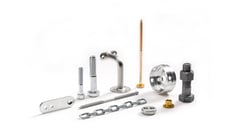- Insights
- The Solutionists Hub
- Common C-Parts Purchasing KPIs, and How to Improve Them
Common C-Parts Purchasing KPIs, and How to Improve Them

In a manufacturing company, everyone has targets to meet, and C-parts purchasers are no exception. Failing to achieve your purchasing KPIs can have effects throughout the company – especially if C-parts availability becomes so low that you risk a line stop in production.
In my role at Bufab, I work closely with purchasers, both inside and outside of the company, but I’ve also previously worked in purchasing roles where Bufab was one of my suppliers – so I’m aware of the kinds of demands and challenges that C-parts purchasers at companies like yours have to deal with during a typical day at work.
In this article, I’m going to present some common KPIs that I think C-parts purchasers are typically assessed on at the companies we work with. You might already be measured on some of them, such as the KPIs related to availability and cost. Some of the others may become more relevant for you in the future, such as those related to sustainability and digitalization. Regardless of whether these KPIs are a part of your role today, I’ll give some advice on how you can boost your performance and ultimately meet them.
Let’s start by taking a look at the most common, and potentially most important KPI for a purchaser like you.
Availability
The consequences of not meeting this KPI can be serious. Ultimately, it’s the purchaser's responsibility to make sure that production has the parts they need when they need them. If this doesn’t happen and essential parts are missing, it can result in a line stop – where the production line is forced to stop until the required parts can be sourced. Downtime is a hugely expensive occurrence for any company, and with the current disruptions in global supply chains, it’s harder than before to find a solution quickly.
So what’s the best way to meet this KPI? As the most fundamental target you have as a C-parts purchaser, there’s lots of contributing factors. But generally, having a consolidated supplier base is a good first step – with a limited number of C-parts suppliers, you have fewer orders and contacts to keep track of, which reduces the risk of mistakes. Other measures depend on your choice of supplier – fast, consolidated deliveries, and potentially some kind of automatic ordering solution can also help make sure your company’s required parts are always in stock.
Your number of suppliers
As a C-parts purchaser, it’s vital you don’t let the number of suppliers in your supplier base get out of control. Even if you’re getting hold of the parts you need, dealing with more and more suppliers all the time is a negative development in the long term. As my colleague Slawomir has explained before, more suppliers means more repetitive work and administration, as well as higher costs.
Instead, you should focus on moving the responsibility for more of your C-parts needs onto fewer, larger suppliers, such as Bufab. This has both short and long-term benefits – such as better relationships with the new supplier and worry-free access to their base of suppliers.
Cost
For purchasers of other types of goods, getting a good price is a vital objective. But for C-parts purchasers, the actual sticker price of the products is less important since the direct cost is always going to be relatively low.
However, the cost, specifically the total cost of ownership (TCO), is an important target for C-parts purchasers. Alongside the price of the parts themselves, there are a large number of other costs around administration, delivery, and storage. If you choose the wrong set of suppliers, these costs can escalate, especially if you have a large, unconsolidated supplier base. The administrative work your purchasing office must do to deal with all these suppliers has a hefty cost – which can turn these very cheap parts into an expensive burden.
Consolidating your supplier base and working only with suppliers who can offer high-quality parts that are delivered on time with a minimum amount of input from you is the best way to keep TCO low and meet this major KPI.
Sustainability
It’s still quite uncommon for C-parts purchasers to have KPIs related to sustainability, although it’s not unheard of.
In future, as sustainability becomes even more important for manufacturing companies, you can expect that these kinds of KPIs will be implemented.
It can be hard to measure sustainability in a way that can easily be turned into a KPI, but it’s possible. Some examples of sustainable KPIs could be the number of suppliers who are ISO 14000 certified, or members of the UN Global Compact. Another KPI could be the proportion of a company’s suppliers who have undergone a certified sustainability audit. Alternatively, the KPIs could focus on the parts themselves, or the way they’ve been delivered – for example, a purchaser could have a KPI focused on keeping the number of C-parts delivered by air freight as low as possible.
It's hard for companies to keep track of the sustainability efforts of all of their suppliers, even for large companies with lots of resources. For that reason, making a real difference to these kinds of KPIs would probably require working with a supply chain partner who can conduct the necessary audits and checks themselves.
Lead times
As I mentioned before, availability is a vital KPI – and lead times are a major part of it. Sometimes, it’s impossible to avoid long lead times for C-parts, especially with the current disruptions in global production and supply chains. However, what really matters is how a purchaser handles these lead times – with good planning and dialogue with the other parts of the company, lead times can be managed and production can stay supplied with the parts it needs.
Sometimes, getting the parts you need may mean having to accept long lead times, or possibly a higher minimum order quantity (MOQ) or price. It’s possible for the purchasing department to handle this calculation themselves, but lots of companies benefit from a supply chain partner in situations like this – by analyzing the operation and the current state of the market, the right partner can guide you in the best direction, or even use their wider supplier base to find an alternative supplier with a better offering.
Digitalization
Similar to sustainability, it can be hard to quantify a supplier’s level of digitalization in a single KPI. However, by focusing on specific aspects of the relationship, it can be done. In my opinion, KPIs related to digitalization will become more common as the industry matures and more sophisticated digital tools are introduced. In practice, a KPI related to digitalization could be the number of suppliers who can offer things like automatic ordering, or incoming order tracking. Dashboards with information on the status of all your C-parts orders can make a purchaser’s life much easier – and it could potentially be a factor in the overall effectiveness of the entire purchasing team.
A KPI like this is improved by carefully choosing your suppliers according to these criteria, or placing pressure on them to improve their digital tools. In both of these cases, it’s probably best to work with a supply chain partner who has both a much wider base of suppliers than your company, and the size and influence to guide them in the right direction.
Get more insights
I hope this article gave you some guidance and inspiration in your purchasing role – as you can tell, supplier consolidation is essential for improving your performance in a lot of these KPIs, so to find out more about it, make sure to download our PPT guide on the topic. You can also get more information in The Purchaser’s Guide to C-Parts¸ an in-depth guide that covers all aspects of C-parts purchasing and contains links to more relevant articles.
The Purchaser's Guide to C-Parts

Get the free guide here
Get new knowledge every week!
Related
-
By Jonas CaseliusHow Does the C-Parts Supplier Consolidation Process Work in Practice?
-
By Oskar SvenssonVendor Managed Inventory: The Benefits of VMI for C-Parts Purchasers
-
By Jacob BergströmWhat is the Total Cost of Ownership in C-Parts Purchasing?
-
By Tuomo TiainenMy Tips for How to Succeed as a C-Parts Purchaser
-
By Carina LööfSustainable Purchasing: Guidance for C-Parts Purchasers
-
By Slawomir BieszkHow to Source C-Parts: Tips for Purchasers
-
By Slawomir BieszkMOQ: How to Deal With High Minimum Order Quantity for C-Parts








.jpeg)